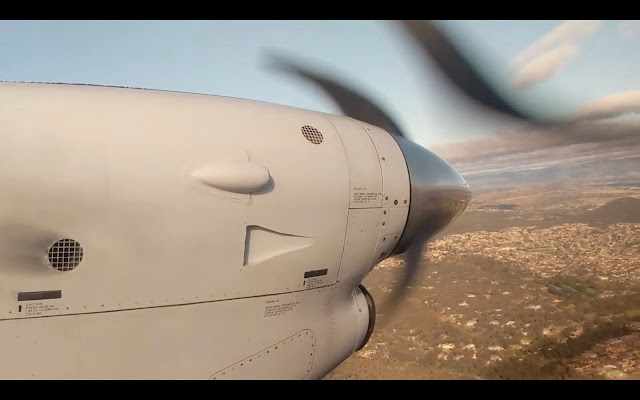Brian Rope |
Photography, Videography
Between
Presumption and Melancholy | Toni Hassan
Huon | Noah
Thompson
The Grand
Scheme | Chris Round
Photo Access
| 27 Apr – 10 Jun
These three exhibitions set out to explore environment and climate threats - two by looking at physical changes made by humans and the third at impacts on particular people.
Toni Hassan is a social practice visual artist, Walkley Award-winning journalist, and Adjunct Research Fellow of the Australian Centre for Christianity and Culture. Between Presumption and Melancholy shows three multimedia artworks from her video series Body and Breath: Remembering Black Summer, 2021-23.
Three women share personal experiences of Australia’s Black Summer of 2019-20. Against the background of an Australian flag in a smoke-free azure sky, Rhian Williams, a volunteer firefighter takes us right into those times of fear. The visual is projected on a translucent curtain that moves such that the flag ripples.
 |
| Toni-Hassan, Video still, 2021, Body and Breath-Remembering-Black Summer - 1 |
Moving
water and moving plane propellors are backgrounds as Sarah Bachelard, a
Canberra-based priest and theologian speaks “It was supposed to be Epiphany, …
coming of the light….We actually changed the hymn we were going to sing, which
was ‘Here in this place a new light is shining’ because, it was just, how could
you sing that?”
 |
| Toni-Hassan, Video still, 2021, Body and Breath-Remembering-Black Summer - 2 |
Luminous and liquid light circles draw us in as Tess Horwitz, the late Canberra artist who created the Bushfire memorial at Mt Stromlo, speaks of "a journey from painful memory and the reality of the day of the fire” and “strength of community and shared experience and on to a very gradual sense of healing and regeneration." We share in her dream.

Toni-Hassan, Video still, 2021, Body and Breath-Remembering-Black Summer - 3
How
should we respond emotionally? Have we had a cathartic experience? Have we
engaged our own grief regarding environmental changes? Hassan also has a book
that includes transcripts of these three plus a further ten interviews.
Noah Thompson seeks to shed light on the continuing conflict between environmental preservation and industrial development in Huon. His large high quality framed inkjet prints are mostly untitled. He has taken inspiration from the destruction of the 2500-year-old Lea Tree – by supporters of the Gordon-below-Franklin project in 1989.
The images are intended to explore continuing tensions between conservation and development. Some are more successful than others. An image of the Lea Tree showing its vandals photographed before their “Fuck You Green Cunts” message painted on the tree’s still burning remains is powerful. Mt Lyell, 2020 presents a severe and disturbing reminder of that mine’s impact.
 |
| Noah Thompson, Mt Lyell, 2020 |
Chris Round has documented The Grand Scheme – the Snowy Hydro. His inkjet prints, also large and high quality, are images taken during the period 2016-2022. They do not include anything from the years before or during construction. They do provide clear evidence as to why he is an award-winning landscape photographer. Round has a book of these and other images available for purchase.
 |
| Chris Round, Intake Tower, 2017 |
Round
has expressed some opinions about hydroelectricity, both positive and negative,
and argues for a balanced approach. He has “not tried to politicise
environmental energy issues” and wonders whether his “approach might be too
sedate”. He describes it as aiming to capture captivating and intriguing images
and suggests that passing judgement would risk stifling conversations. I am not
convinced and confess disappointment with the content of the works displayed.
Having first visited the Scheme and the area in 1958 and many times since, did I unfairly expect more? During the exhibition opening, a comment was made that it was refreshing to see straight photography on the gallery walls. Whilst, perhaps, it has become less common to see such works at this venue, I would question why that is necessarily “refreshing”. More contemporary artworks would have challenged me and stimulated greater consideration of the important issues these three shows were meant to present to us.
This review was first published by The Canberra Times on 13/5/23 - on page 10 of Panorama and online here. It is also available on the author's blog here.